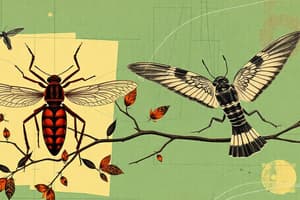Podcast
Questions and Answers
What triggers the release of ecdysones in insects undergoing transformation?
What triggers the release of ecdysones in insects undergoing transformation?
Insects that undergo complete metamorphosis typically have how many stages in their life cycle?
Insects that undergo complete metamorphosis typically have how many stages in their life cycle?
What is another term for incomplete metamorphosis?
What is another term for incomplete metamorphosis?
Which hormone is responsible for signaling the start of moulting in insects?
Which hormone is responsible for signaling the start of moulting in insects?
Signup and view all the answers
What is the name of the stage an insect goes through after the larva stage in complete metamorphosis?
What is the name of the stage an insect goes through after the larva stage in complete metamorphosis?
Signup and view all the answers
What is the protective casing called during the transformation from larva to adult in insect metamorphosis?
What is the protective casing called during the transformation from larva to adult in insect metamorphosis?
Signup and view all the answers
Which of the following best describes the egg-laying process of female insects?
Which of the following best describes the egg-laying process of female insects?
Signup and view all the answers
What is the main purpose of insect metamorphosis?
What is the main purpose of insect metamorphosis?
Signup and view all the answers
Which of the following is NOT a characteristic of larvae during the larval stage of insect metamorphosis?
Which of the following is NOT a characteristic of larvae during the larval stage of insect metamorphosis?
Signup and view all the answers
How do insects typically reproduce in terms of egg production?
How do insects typically reproduce in terms of egg production?
Signup and view all the answers
Study Notes
Insect Metamorphosis
Insects undergo fascinating changes during their life cycle, known as insect metamorphosis or complete metamorphosis. This life cycle consists of three main stages: egg, larva, and adult. The process involves several transformations that prepare the offspring to navigate their environment effectively. Here's an overview of how insect metamorphosis happens:
Life Cycle Stages
Egg Stage
The life cycle begins when an adult female insect lays her eggs. These eggs can be laid directly onto leaves or other surfaces, or they may be attached to spines of insects called phytophagous insects. Bugs reproduce sexually; the female releases eggs into the environment without any aid from males. A large number of eggs are laid because only a few will survive until adulthood.
Larval Stage
Once hatched, the insect is in its larval stage. This stage often involves a significant increase in size, with organs developing and maturing. Larvae can have different appearances and behaviors depending on the species. For example, some caterpillars have legs while others do not. Some larvae feed on plant matter while others consume fungi or decaying organic materials.
Pupal Stage
The transformation from a larva to an adult—called pupation—occurs within a protective casing called a chrysalis or cocoon. During this time, the larval structures break down, and new tissues grow to form the imago or adult body. This process is so complete that it's sometimes referred to as being born again.
Triggers for Transformation
The transformation from egg to adult occurs due to several factors, including ambient temperature, food availability, and growth development. When these conditions are right, an endocrine hormone called prothoracicotropic hormone is released. This hormone signals the release of ecdysones, which cause moulting and transformation to the next stage. Once transformed, the insect is ready to mate and lay eggs, starting the cycle all over again.
Differences Between Complete and Incomplete Metamorphosis
Complete metamorphosis, where an insect goes through four stages (egg, larva, pupa, adult), is also known as holometabolism. On the other hand, incomplete metamorphosis, where an insect has three stages (egg, nymph, adult) and gradually develops wings, is known as hemimetabolism. Most true bugs undergo complete metamorphosis, while many insects like grasshoppers and termites experience incomplete metamorphosis.
Studying That Suits You
Use AI to generate personalized quizzes and flashcards to suit your learning preferences.
Description
Explore the fascinating process of insect metamorphosis, consisting of three main stages: egg, larva, and adult. Learn about the triggers for transformation and the differences between complete and incomplete metamorphosis.




